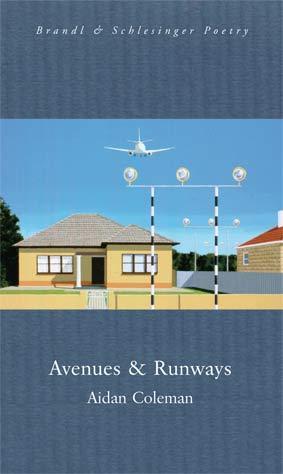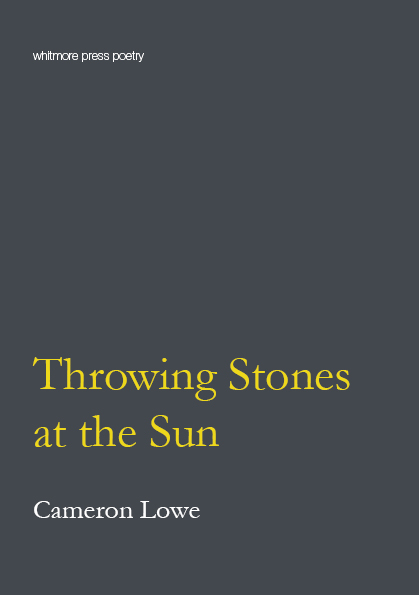
- Free Article: No
- Contents Category: Poetry
- Review Article: Yes
- Article Title: Fine adjustments
- Online Only: No
- Custom Highlight Text:
Each of these three books is its author’s first, and each carries a cover endorsement by two distinguished poets. You can tell a lot about the books from looking at who endorses whom before you need even to read one of the poems.
The rear cover of Aidan Coleman’s Avenues & Runways (endorsements by Kevin Hart and Peter Goldsworthy) describes him as an imagist. Whatever the exact significance of that term, there is no doubt that this poetry belongs to the class that has slight outward show and rich implications. And the pleasure of reading them is the shuttling between the two. There are at least two important requirements here: the surface has to be elegant and engaging without being slovenly or cute (ah, if you only knew what treasures I conceal!); implications must be intense and never clichéd.
- Book 1 Title: Avenues & Runways
- Book 1 Biblio: Brandl & Schlesinger, $22.95 pb, 66 pp
- Book 1 Cover Small (400 x 600):

- Book 1 Cover (800 x 1200):

- Book 2 Title: Throwing Stones at the Sun
- Book 2 Biblio: Whitmore Press, $16.50 pb, 31 pp
- Book 2 Cover Small (400 x 600):

- Book 2 Cover (800 x 1200):

- Book 3 Title: Narcissism
- Book 3 Biblio: Whitmore Press, $16.50 pb, 31 pp
- Book 3 Cover Small (400 x 600):

- Book 3 Cover (800 x 1200):

Avenues & Runways meets these tests pretty well, and it is a book that grows on you. It is difficult to describe the poems without analysing at least one carefully, but much of the implication is left until the final lines. This gives the poems a similar basic structure. The first poem, ‘Sun in Winter’, concludes by evoking the notion that light and warmth are absorbed by the natural world and can be reclaimed from them: ‘you don’t need a big backyard / for sun: a deckchair / and a lemon tree, its pockets bulging.’ In other poems, a crane over the city at night is ‘fishing in the shadows’, an airport is ‘calling in lost stars’, and at six a.m. you can hear the dew ‘tinkering, with fine adjustments’. Isolated like this, they sound a bit precious, but their task is to lift each poem away from the reality in which it is founded.
No surprises then that one of the dominant images is that of taking off – something both planes and poems do. A poem such as ‘I Like Airports’ doesn’t just speak about planes. It concludes:
And every avenue ends in take-off:
every poem begins
on the ground
then is shot heavenward.
The ordinary that provides the avenues and runways for these poems is very suburban, and its inhabitants often seem to be operating at night or, in one fine sequence, in rain. This suggests that the base world is a little distorted, and that the closing image will, in contrast, be precise. One of the nicest of the book’s many fine poems is ‘Mythology’, which briefly describes an uninspiring childhood:
Home never seemed worth writing about.
The place was post-history:
red brick and straight as an equals sign.
There were no ghosts
and no grandparents to elegise.
All the clocks were electronic.
before finishing luminously:
But the same moon shone above the ancient hills:
a guide: a dazzling portal.
Cameron Lowe’s Throwing Stones at the Sun is endorsed by Gig Ryan and Alison Croggon, and attractively blends a light surrealism with documenting a suburban life in Melbourne. Some of it reads like a homage to John Forbes, whose poetic turns of phrase recur regularly – ‘Waving’ is a good (or bad) example. If this is conscious homage, I guess that is fine – no one deserves homage more than Forbes, who showed poets how exquisitely structured, in terms of syntax and content, a short surreal lyric could be. Lowe’s book has a lot of successful poems in which contemporary life overlays a personal life of erotic unease – which, come to think of it, is also a Forbesian trope.
There is a group of poems in two-line stanzas spaced throughout the book that seems to document unhappy loves: ‘You’re gone & the sky / is empty of ideas’; ‘Whisper farewell in my ear if you will / but remember this & this & this.’ What stops this becoming unbearably lugubrious are the sparkling poems between them, which celebrate, for example, the way a cooking sausage on the breeze whispers ‘it’s summer, it’s summer’ or the way a vision of a sympathetic natural world on Port Philip Bay has a foreground:
where an elegant couple
admire their Land Rover, slick
in sea shades, The Age real estate section
stuck between them like a gesture to love.
The best response to first books is to try to estimate what the best path would be for this poet in the future. In this case, it is not a question I am sure I can answer. All I can say is that this book has a delicate mix that works well but probably shouldn’t become a habit of style.
Coleman’s and Lowe’s books operate in reasonably familiar modes. Reading Maria Takolander’s Narcissism (Peter Rose and Paul Kane, the endorsers) is a very different experience: much more challenging and, to a degree, disturbing. The poems are very finished, almost impenetrably polished; they are also very lucid, despite the fact that several readings often leave you struggling for a way to get into them.
Some it is possible to feel at home in. ‘Tides’ is an unusual look at the Madrid terror attacks, and the poem that precedes it is probably also about terrorism. Even here, the emphasis is on surprising perspectives:
Here the tracks are sleeping with bodies,
Clock touchers, anonymous lovers,
Swaying together on just such mornings,Scorched and flung apart.
Dismembered fish and rock torn gulls.
In the unfurled trains, fires, residual, are made from air.
Another friendly and approachable poem, ‘Whale Watching’ (first published in these pages), describes the tremendous events of the poet seeing whales giving birth, while her partner’s child wanders off:
These whales are more warm-blooded than me.
I stand a zealot among zealots,Waiting for the tear, the breach:
Error or revelation.When I find you at my side again,
She’s sand-covered and crying.
I learn she’s lost her Tic Tacs.
‘Paranoia’ is an unusual but funny poem about, well, paranoia. Indeed, a number of these poems deal with what might be called states – insomnia, euphoria, paranoia, sleep, grief and narcissism – sometimes clearly (in ‘Insomnia’ the writer chases sleep ‘as I would an orgasm’) and sometimes, as in ‘Grief’, very opaquely.
The keystone poem may well be the first, ‘Cosmetics Department’. This brittle piece about a brittle environment begins, ‘Among so many reflections / There can be no need for reflection’ and concludes, ‘this fragrance shatters teeth’. I am sure it is not intended, but there is something of a description of the effect that this book’s always polished, always surprising method has on its readers. At all events, Narcissism is a book of great accomplishment and its vision is one that it would be interesting to explore at greater length than is possible in the nineteen poems included here.
Brandl & Schlesinger’s books are always elegant, and the two books from Whitmore Press are beautifully designed (by Anthony Lynch). May all publishers prepared to bring out books by good new poets receive the rewards they deserve, if not on earth, then in heaven – where they take poetry seriously.


Comments powered by CComment